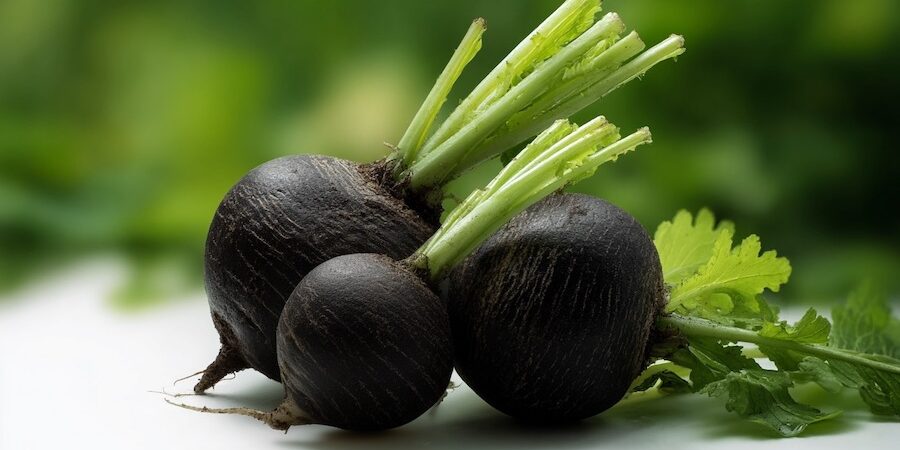The black radish (Raphanus sativus var. niger) is a root vegetable with a distinctive appearance and flavour, which has been known and used for medicinal purposes since ancient times. Its dark brown or blackish skin and snow-white flesh form a unique contrast. Among the radishes, this variety is particularly rich in essential oils and glucosinolates, which give it a powerful antibacterial, liver-cleansing and digestive action.
The black radish originated in Central Asia, but it was also consumed by the Egyptians and was even considered a medicinal herb. Today, it is mainly grown in the central and eastern regions of Europe, with significant production in Germany, Poland and Hungary.
Its health benefits include supporting bile production, relieving coughs, alleviating indigestion and benefiting liver function. Its high fibre content aids digestion, while its low calorie content means it can be included in diets.
Specificities of black radish cultivation
Black radish is a typical autumn-winter vegetable grown in the open field. The sowing season typically starts in mid-summer and harvesting takes place in autumn until the frosts set in. Because it tolerates cold well, it can often be stored for longer periods. It is most widely grown in Germany and Poland, but can also be found on many farms in Hungary, especially in the Great Plain and parts of the Transdanubian region.
You can find it in shops mostly from October to March. Black radishes of Hungarian origin are mainly available from November to February, while imported products (mainly Polish or German) are often found at the beginning and end of the season.
How to choose a good quality black radish?
There are a few things to consider when buying:
- The skin of the radish should be smooth, free from damage, cracks or soft spots.
- To the touch, it should be firm and compact – a softer specimen will have lost some of its moisture and may be hollow inside.
- Too large specimens are more prone to hollowing out, so go for medium-sized pieces.
- The smell should be fresh, slightly pungent, but not fermented or rotten.
How to use black radish in the kitchen?
Black radish is mainly eaten raw for its distinctive, slightly pungent flavour, but it can also be prepared in a variety of ways. Its culinary uses are versatile:
- Grated, it is excellent for salads, and mixed with sour cream or yoghurt it makes a great dip.
- Thinly sliced, it makes an excellent sandwich topping, especially with fatty or buttery bread dishes.
- It can also be grated into soups, where it adds a distinctive flavour to the dish.
- As a roasted vegetable or stir-fried, it can also be an exciting side dish, although its spiciness is reduced by cooking.
- It is also known as a home-made cough syrup: hollowing out the black radish and infusing it with honey produces a natural syrup that relieves sore throats and coughs in a few hours.
How to store black radishes?
It keeps its freshness best in a cool, dry place. Ideal storage conditions:
- It will keep for up to 2-3 weeks in the vegetable drawer of a refrigerator if the environment is not too humid.
- An airy cellar or pantry is also a good place for storage, especially for larger quantities.
- It is important not to wash them in advance, as moisture accelerates spoilage. Clean only immediately before use.
Interesting facts about black radishes
- Black radish has been a popular staple of folk medicine – particularly for its liver cleansing and expectorant properties.
- Ancient Egyptians also gave radishes to workers building pyramids, as they were believed to increase work resistance.
- The peel of the black radish root is particularly rich in antioxidants, so instead of peeling it, a thorough washing can retain its valuable active ingredients.
- It is a member of the radish family, so its relatives include the month radish and the Japanese daikon.
Tips for using black radish in the kitchen
- If you find it too spicy, it is best to salt it slightly after grating and then squeeze it out after a few minutes – this will give it a milder, silkier flavour.
- Mixed with a yoghurt dressing, it makes a great pickle base, which also goes well with grilled meats.
- With a little lemon juice or apple cider vinegar, you can make a refreshing, invigorating salad that can also be served as a stand-alone dish.
- Try it roasted with honey, where it is combined with sweet aromas to give a new look to this spicy vegetable.


